Illusion of Face
since June 21, 2007
"An illustration of the Thatcher illusion"
The left image shows an upside-down image of an illustration of a smiling lady. The right image is different from the left one, in which each of eyes and the mouth is inverted in the inverted face. Observers do not feel it bizarre so much, while it appears to be rather bizarre when the image is inverted and the face is upright (see below). This effect is called the Thatcher illusion (Thompson, 1980). Peter's page
Copyright Akiyoshi Kitaoka 2007 (November 15)
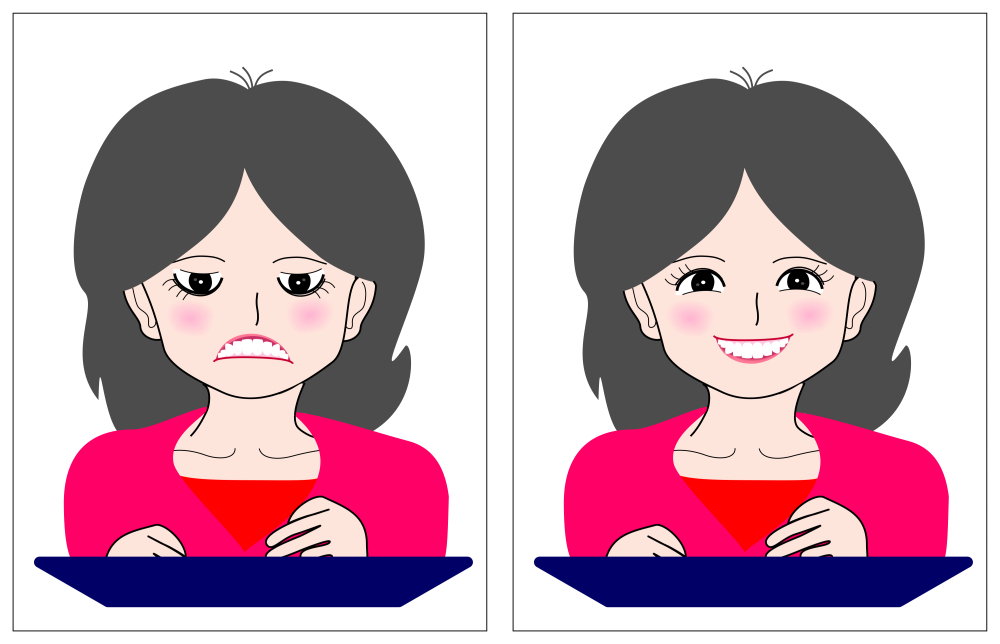
References
Arnheim, R. (1954) Art and visual perception: A psychology of the eye. Berkeley: University of California Press.
Bartlett, J. C. and Searcy, J. (1993) Inversion and configuration of faces. Cognitive Psychology, 25, 281-316.
Bertin, E. and Bhatt, R. S. (2004) The Thatcher illusion and face processing in infancy. Developmental Science, 7, 431?436.
Boutsen, L. and Humphreys, G. W. (2002) Face context interferes with local part processing in a prosopagnosic patient. Neuropsychologia, 40, 2305-2313.
Boutsen, L. and Humphreys, G. W. (2003) The effect of inversion on the encoding of normal and "thatcherized" faces. Quarterly Journal of Experimental Psychology A, 56, 955-975.
Boutsen, L., Humphreys, G. W., Praamstra, P., and Warbrick T. (2006) Comparing neural correlates of configural processing in faces and objects: an ERP study of the Thatcher illusion. Neuroimage, 32, 352-367.
Carbon, C. C., Schweinberger, S. R., Kaufmann, J. M., and Leder H. (2005) The Thatcher illusion seen by the brain: an event-related brain potentials study. Cognitive Brain Research, 24, 544-555.
Carey, S. and Diamond, R. (1977) From piecemeal to configurational representation
of faces. Science, 195 (4275), 312-314.
Diamond, R. and Carey, S. (1986) Why faces are and are not special: An effect of expertise. Journal of Experimental Psychology: General, 115, 107-117.
Edmonds, A. J. and Lewis, M. B. (2007) The effect of rotation on configural encoding in a face-matching task. Perception, 36, 446-460.
Ellis, H. D. (1975) Recognising faces. British Journal of Psychology, 66, 409-426.
Farah, M. J., Tanaka, J. W., and Drain, H. M. (1995) What causes the face inversion effect? Journal of Experimental Psychology: Human Perception and Performance, 21, 628-634.
Goldstein, A. G. (1965) Learning of inverted and normally oriented faces in children and adults. Psychonomic Science, 3, 447-448.
Leder, H., Candrian, G., Huber, O., and Bruce, V. (2001) Configural features in the context of upright and inverted faces. Perception, 30, 73-83.
Lewis, M. B. (2001) The Lady's not for turning: Rotation of the Thatcher
illusion. Perception, 30, 769-774.
Lewis, M. B. (2003) Thatcher's children: Development and the Thatcher illusion.
Perception, 32, 1415-1421.
Lewis, M. B. and Johnston, R. A. (1997) The Thatcher illusion as a test of configural disruption. Perception, 26, 225-227.
Lobmaier, J. S. and Mast, F. W. (2007) The Thatcher illusion: Rotating the viewer instead of the picture. Perception, 36, 537-546.
Milivojevic, B., Clapp, W. C., Johnson, B. W., and Corballis, M. C. (2003) Turn that frown upside down: ERP effects of thatcherization of misorientated faces. Psychophysiology, 40, 967-978.
Murray, J. E., Yong, E., and Rhodes, G. (2000) Revisiting the perception of upside-down faces. Psychological Science, 11, 492?496.
Parks, T. E. (1983) Letters to the Editor. Perception, 12, 88.
Parks, T. E., Coss, R. G., and Coss, C. S. (1985) Thatcher and the Cheshire cat: context and the processing of facial features. Perception, 14, 747-754.
Rakover, S. S. (1999) Thompson's Margaret Thatcher illusion: when inversion
fails. Perception, 28, 1227-1230.
Rakover, S. S. and Teucher, B. (1997) Facial inversion effects: parts and whole relationship. Perception & Psychophysics, 59, 752-761.
Rhodes, G., Brake, S., and Atkinson, A. P. (1993) What's lost in inverted faces? Cognition, 47, 25-57.
Rock, I. (1974) The perception of disoriented figures. Scientific American, 230, 78-85.
Rock, I. (1988) On Thompson's inverted-face phenomenon (Research Note).
Perception, 17, 815-817.
Rouse, H., Donnelly, N., Hadwin, J. A., and Brown, T. (2004) Do children with autism perceive second-order relational features? The case of the Thatcher illusion. Journal of Child Psychology and Psychiatry, 45, 1246?1257.
Sjoberg, W. and Windes, J. (1992) Recognition times for rotated normal
and "Thatcher" faces. Perceptual and Motor Skills, 75, 1176-1178.
Sturzel, F. and Spillmann, L. (2000) Thatcher illusion: Dependence on angle of rotation. Perception, 29, 937-942.
Tanaka, J. W. and Farah, M. J. (1993) Parts and wholes in face recognition. Quarterly Journal of Experimental Psychology A., 46, 225-245.
Thompson, P. (1980) Margaret Thatcher: a new illusion. Perception, 9, 483-484.
Valentine, T. (1988) Upside-down faces: A review of the effect of inversion upon face recognition. British Journal of Psychology, 79, 471-491.
Valentine, T. and Bruce, V. (1988) What's up? The Margaret Thatcher illusion
revisited. Perception, 14, 515-516.
Yin, R. K. (1969) Looking at upside-down faces. Journal of Experimental Psychology, 81, 141-145.
"To read, or not to read"
The four images are the same, but only the lower-left lady tends to appear to read the book while the other three do not appear to see the book.
Copyright Akiyoshi Kitaoka 2007 (June 20)
"Upside-down face overestimation illusion"
The lower face appears to be larger than the upper one though they are identical in size.
Copyright Akiyoshi .Kitaoka 2007 (February 16)
"Size-dependent sight-direction illusion"
When this image is large enough, the girl appears to see a slightly lower place whereas when this image is small, she appears to look in front.
Copyright Akiyoshi .Kitaoka 2007 (May 3)
Putting on and taking off glasses give the same effect. cf. Hybrid Images by Oliva (MIT)
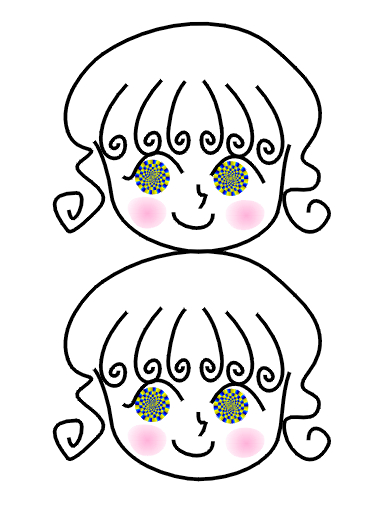
"Jastrow illusion of face"
The lower face appears to be larger than the upper one though they are identical in size.
Copyright Akiyoshi Kitaoka 2006 (August 4)

"Head height illusion"
The height of the head appears to be the larges in the rightmost image, though all images have the same head height.
Copyright Akiyoshi Kitaoka 2006 (August 2)
"Wollaston illusion 3"
In image 1 the girl appears to look downward, while in image 2 (when the cursor is put on the image) she appears to see slightly upward. Actually, only the position of the contours of the head and face is different between the two images.
Copyright Akiyoshi .Kitaoka 2006 (July 21)
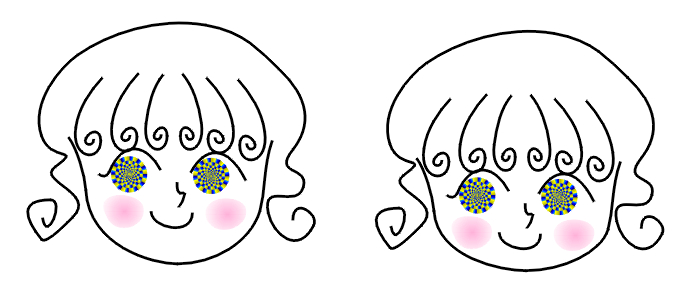
"Wollaston illusion 2"
In image 1 the girl appears to look up, while in image 2 (when the cursor is put on the image) she appears to see you. Actually, only the position of the contours of the head and face is different between the two images.
Copyright Akiyoshi Kitaoka 2006 (July 21)
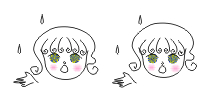
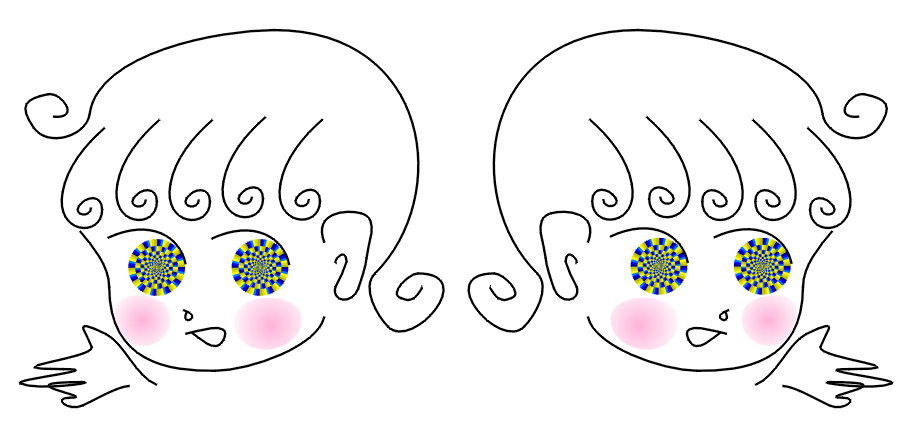
"Wollaston illusion"
The left girl appears to gaze at you while the right one appears to see rightward, though the eyes are identical to each other. This phenomenon was proposed by Wollaston (1824).
Copyright Akiyoshi Kitaoka 2006 (July 20)
Wollaston, W. H. (1824) On the apparent direction of eye in a portrait. Philosophical Transactions of the Royal Society of London, B114, 247-256. (I do not have the copy, so I have not confirmed this paper yet; I have got it on February 28, 2008! Thanks to Chris!)